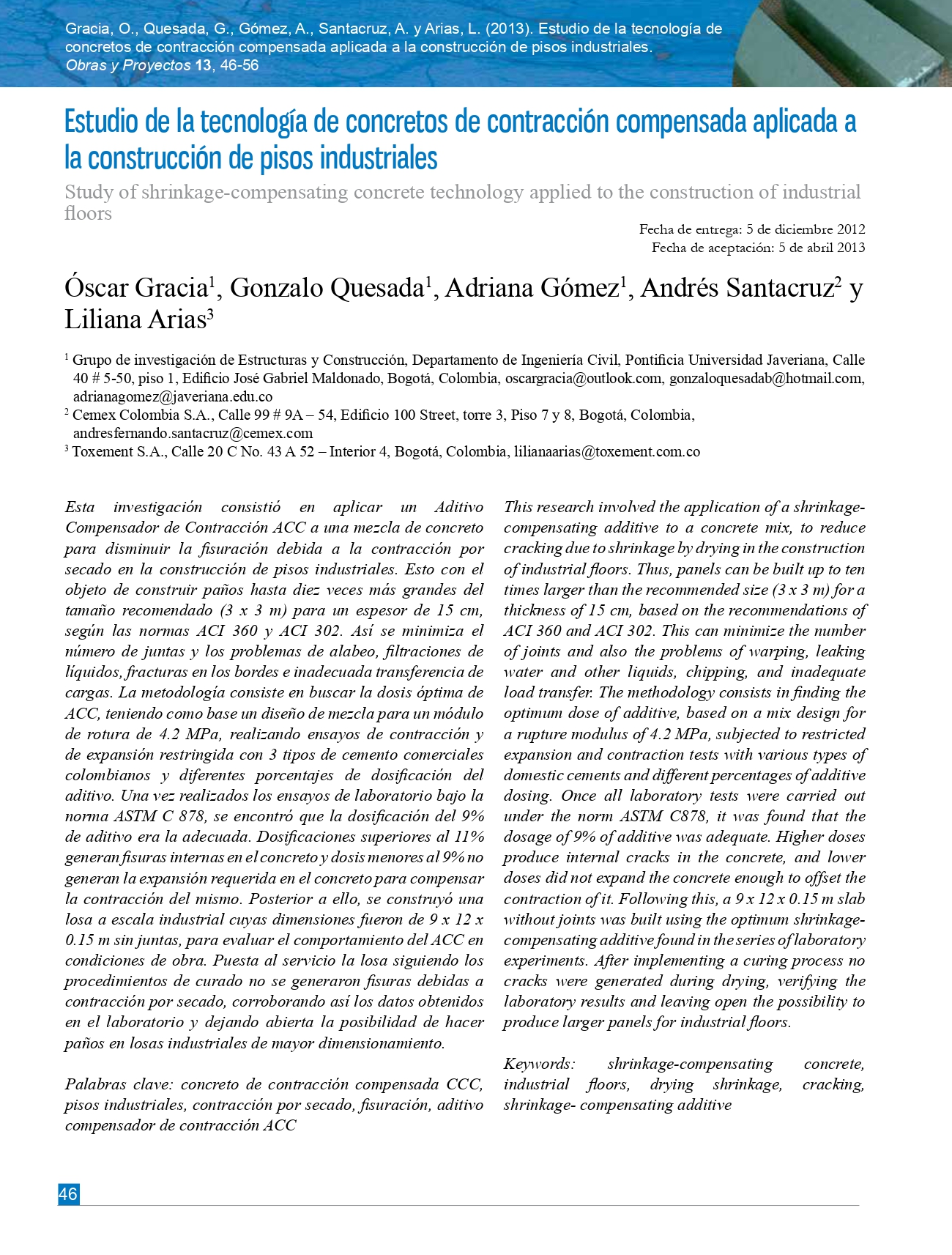Study of shrinkage-compensating concrete technology applied to the construction of industrial floors
DOI:
https://doi.org/10.4067/S0718-28132013000100005Keywords:
shrinkage-compensating concrete, industrial floors, drying shrinkage, cracking, shrinkage- compensating additiveAbstract
This research involved the application of a shrinkage-compensating additive to a concrete mix, to reduce cracking due to shrinkage by drying in the construction of industrial floors. Thus, panels can be built up to ten times larger than the recommended size (3 x 3 m)for a thickness of 15 cm, based on the recommendations of ACI360 and ACI302. This can minimize the number of joints and also the problems of warping, leaking water and other liquids, chipping, and inadequate load transfer. The methodology consists in finding the optimum dose of additive, based on a mix design for a rupture modulus of 4.2 MPa, subjected to restricted expansion and contraction tests with various types of domestic cements and different percentages of additive dosing. Once all laboratory tests were carried out under the norm ASTM C878, it was found that the dosage of 9% of additive was adequate. Higher doses produce internal cracks in the concrete, and lower doses did not expand the concrete enough to offset the contraction of it. Following this, a 9 x 12 x 0.15 m slab without joints was built using the optimum shrinkage-compensating additive found in the series of laboratory experiments. After implementing a curing process no cracks were generated during drying, verifying the laboratory results and leaving open the possibility to produce larger panels for industrial floors.
References
ACI 223 (2010). Guide for the use of shrinkage-compensating concrete. ACI Committee 223R-10, Farmington Hills, MI, USA.
ACI 301 (2010). Specifications for Structural Concrete. ACI Committee 301-10, Farmington Hills, MI, USA.
ACI 302 (2004). Guide for concrete floor and slab construction. ACI Committee 302.1R-04, Farmington Hills, MI, USA.
ACI 360 (2010). Guide to Design of Slabs-on-Ground. ACI Committee 360R-10, Farmington Hills, MI, USA.
ASTM C150 (2012). Standard Specification for Portland Cement. West Conshohocken, PA, USA.
ASTM C157 (2008). Standard test method for length change of hardened hydraulic-cement mortar and concrete. West Conshohocken, PA, USA.
ASTM C878 (2009). Standard test method for restrained expansion of shrinkage-compensating concrete. West Conshohocken, PA, USA.
Collepardi, M., Troli, R., Bressan, M., Liberatore, F. and Sforza, G. (2008). Crack-free concrete for outside industrial floors in the absence of wet curing and contraction joints. Cement and Concrete Composites 30, Issue 10, 887-891. https://doi.org/10.1016/j.cemconcomp.2008.07.002
Luco, L. F., Pombo, R. and Torrent, R. (2003). Shrinkage-compensating concrete in Argentina. Concrete International 25(5), 91-101.
Mendoza, C. J., Untiveros, A., Máximo, C. y Dávila, P. (2011). Influencia de las fibras de polipropileno en las propiedades del concreto en estados plástico y endurecido. Concreto y cemento: Investigación y Desarrollo 2(2), 35-47.
Monteiro, P.J.M. and Mehta, P.K. (1986). The transition zone between aggregate and type K expansive cement. Cement and Concrete Research 16(1), 111-114. https://doi.org/10.1016/0008-8846(86)90075-X
Nagataki, S., and Gomi, H. (1998). Expansive admixtures (mainly ettringite). Cement and Concrete Composites 20(2-3), 163-170. https://doi.org/10.1016/S0958-9465(97)00064-4
NTC 2871 (2004). Método de ensayo para determinar la resistencia del concreto a la flexión - utilizando una viga simple con carga en los tercios medios. Norma Técnica Colombiana.

Downloads
Published
Issue
Section
License
Copyright (c) 2013 Universidad Católica de la Santísima Concepción

This work is licensed under a Creative Commons Attribution-NonCommercial 4.0 International License.







